Ryobi BS901 User Manual
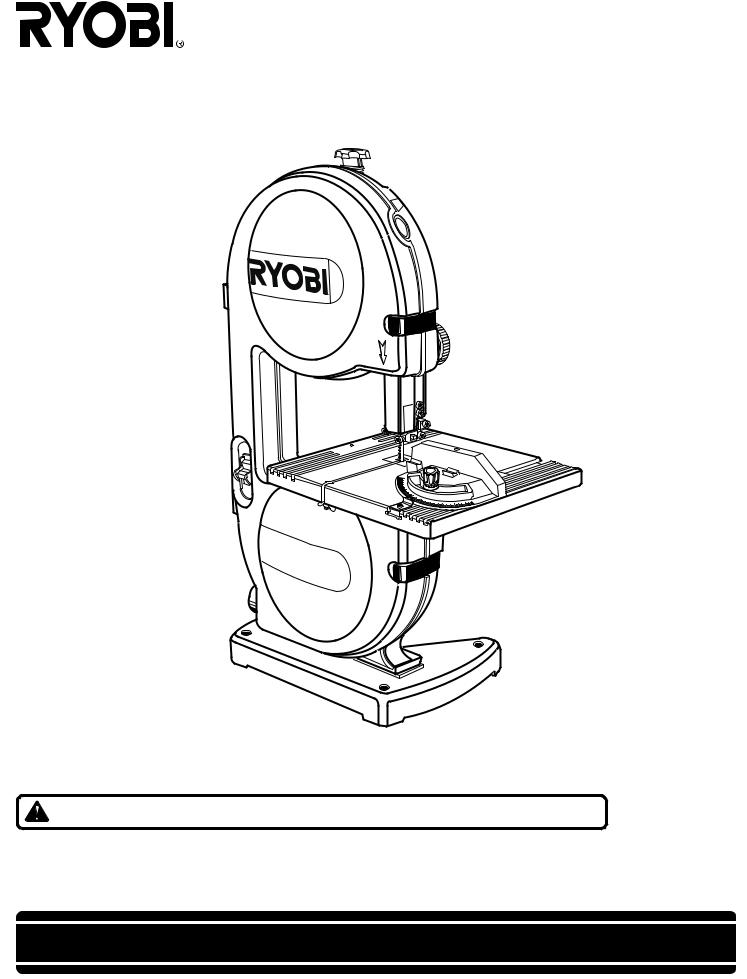
OPERATOR'S MANUAL
9 in. (229 mm) BAND SAW Model BS901
9” BAND SAW
ON
RTOEMLOOVCEK
O
03
4
5
6 0
75
90
75
60
30
45
THANK YOU FOR BUYING A RYOBI BAND SAW.
Your new Band Saw has been engineered and manufactured to Ryobi's high standards for dependability, ease of operation, and operator safety. Properly cared for, it will give you years of rugged, trouble-free performance.
CAUTION: Carefully read through this entire operator's manual before using your new saw.
Pay close attention to the Rules for Safe Operation, Warnings, and Cautions. If you use your saw properly and only for what it is intended, you will enjoy years of safe, reliable service.
Please fill out and return the Warranty Registration Card so we can be of future service to you.
Thank you again for buying Ryobi tools.
SAVE THIS MANUAL FOR FUTURE REFERENCE
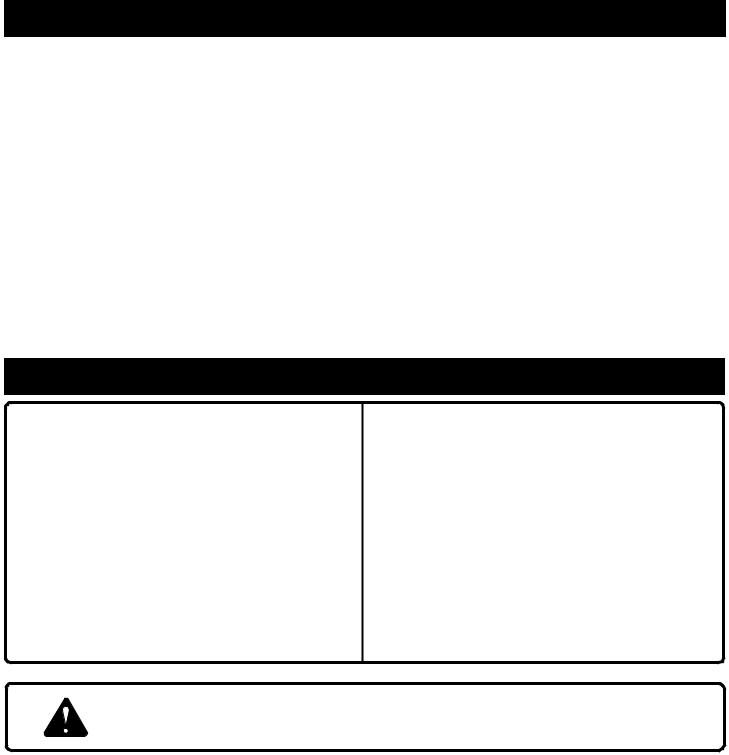
|
TABLE OF CONTENTS |
|
■ Table of Contents and Product Specifications ............................................................................................ |
2 |
|
■ Rules for Safe Operation ......................................................................................................................... |
3-5 |
|
■ |
Electrical ...................................................................................................................................................... |
6 |
■ Glossary of Terms and Unpacking .............................................................................................................. |
7 |
|
■ Loose Parts List and Tools Needed ............................................................................................................ |
8 |
|
■ |
Features ...................................................................................................................................................... |
9 |
■ |
Assembly .............................................................................................................................................. |
10-11 |
■ |
Adjustments ......................................................................................................................................... |
11-15 |
■ |
Operation ............................................................................................................................................. |
16-17 |
■ |
Maintenance......................................................................................................................................... |
18-19 |
■ |
Troubleshooting ........................................................................................................................................ |
20 |
■ |
Parts Ordering / Service ............................................................................................................................ |
22 |
|
PRODUCT SPECIFICATIONS |
|
Blade Width |
1/8 in. to 3/8 in. |
|
(3 mm to 10 mm) |
Blade Length |
59-1/2 in. |
|
(151 cm) |
Frame to Blade Capacity |
9 in. |
|
(229 mm) |
Cutting Thickness Capacity |
3-1/8 in. |
|
(80.0 mm) |
Table Size |
11-3/8 in. x 11-3/8 in. |
|
(28.9 cm x 28.9 cm) |
Table Tilt |
0° - 45° |
Input |
2.3 Amperes |
Rating |
120 Volt, 60Hz |
|
AC Only |
No Load Speed |
2900 SFPM |
Overall Dimensions |
19-1/2 in. x 12-1/2 in. x 28 in. |
|
(49.5 cm x 31.8 cm x 71.17 cm) |
Net Weight |
37 lbs. |
|
(17.8 kg) |
Dust Port |
1-3/4 in. |
|
(44.5 mm) |
Look for this symbol to point out important safety precautions. It means attention!!! Your safety is involved.
Page 2
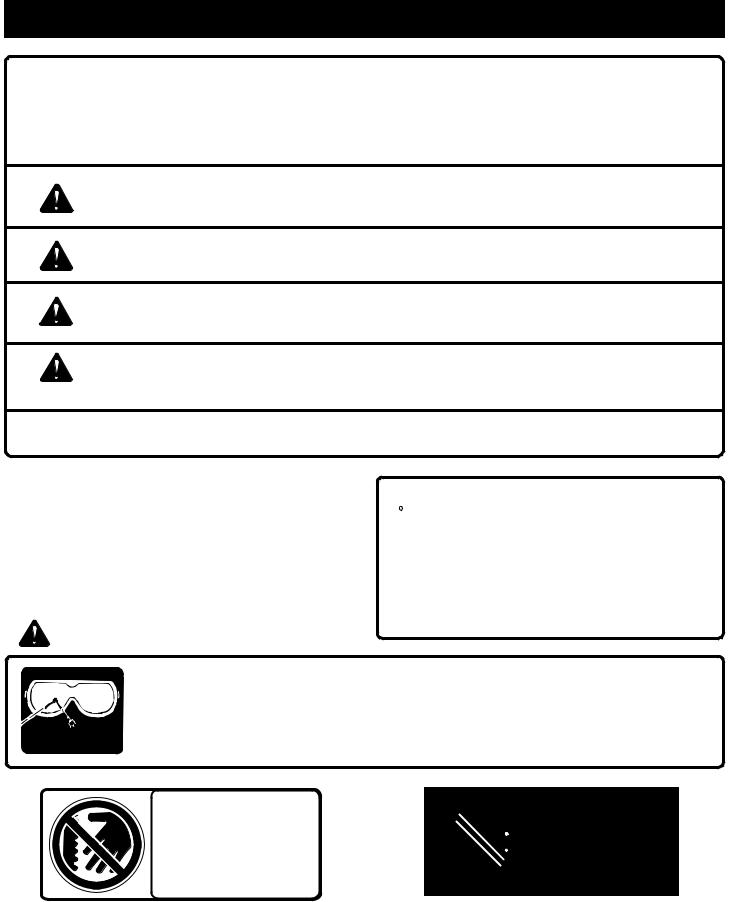
RULES FOR SAFE OPERATION
The purpose of safety symbols is to attract your attention to possible dangers. The safety symbols, and the explanations with them, deserve your careful attention and understanding. The safety warnings do not by themselves eliminate any danger. The instructions or warnings they give are not substitutes for proper accident prevention measures.
SYMBOL MEANING
SAFETY ALERT SYMBOL:
Indicates danger, warning, or caution. May be used in conjunction with other symbols or pictographs.
DANGER: Failure to obey a safety warning will result in serious injury to yourself or to others. Always follow the safety precautions to reduce the risk of fire, electric shock and personal injury.
WARNING: Failure to obey a safety warning can result in serious injury to yourself or to others. Always follow the safety precautions to reduce the risk of fire, electric shock and personal injury.
CAUTION: Failure to obey a safety warning may result in property damage or personal injury to yourself or to others. Always follow the safety precautions to reduce the risk of fire, electric shock and personal injury.
NOTE: Advises you of information or instructions vital to the operation or maintenance of the equipment.
IMPORTANT
Servicing requires extreme care and knowledge and should be performed only by a qualified service technician. For service we suggest you return the tool to your nearest RYOBI AUTHORIZED SERVICE CENTER for repair. When servicing, use only identical Ryobi replacement parts.
WARNING:
 WARNING:
WARNING:
Do not attempt to operate this tool until you have read thoroughly and understand completely all instructions, safety rules, etc. contained in this manual. Failure to comply can result in accidents involving fire, electric shock, or serious personal injury. Save this operator's manual and review frequently for continuing safe operation and instructing others who may use this tool.
WEAR YOUR
SAFETY GLASSES
FORESIGHT IS BETTER
THAN NO SIGHT
The operation of any band saw can result in foreign objects being thrown into your eyes which can result in severe eye damage. Before beginning power tool operation, always wear safety goggles or safety glasses with side shields and a full face shield when needed. We recommend Wide Vision Safety Mask for use over eyeglasses or standard safety glasses with side shields.
WARNING:
KEEP HANDS AWAY |
DO NOT EXPOSE |
|
FROM BLADE. FAILURE |
TO RAIN OR USE IN |
|
TO HEED THIS WARNING |
DAMP LOCATIONS |
|
COULD RESULT IN |
||
|
||
SERIOUS INJURY. |
|
Page 3
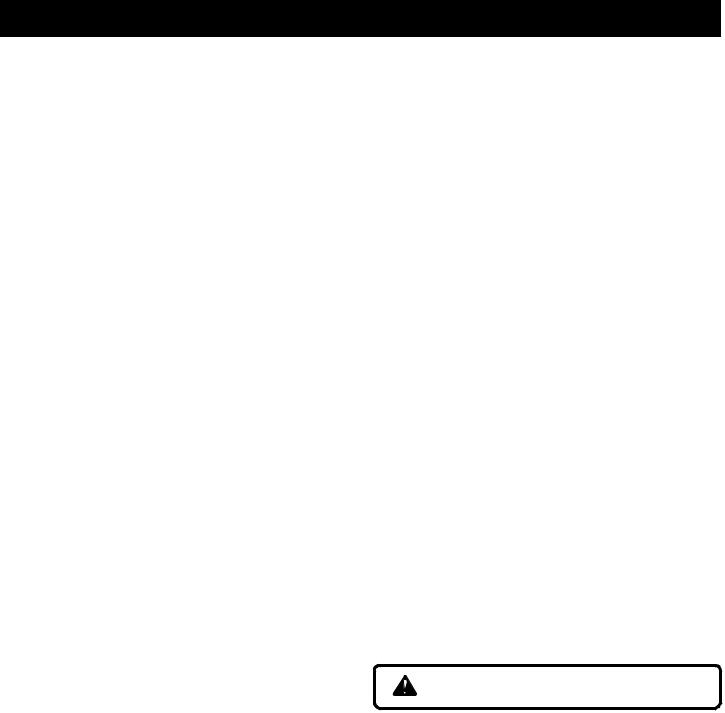
RULES FOR SAFE OPERATION
Safe operation of this power tool requires that you read and |
■ MAINTAIN TOOLS WITH CARE. Keep tools sharp and |
|
understand this operator's manual and all labels affixed to |
clean for best and safest performance. Follow instructions |
|
the tool. Safety is a combination of common sense, staying |
for lubricating and changing accessories. |
|
alert, and knowing how your band saw works. |
■ DISCONNECT ALL TOOLS. When not in use, before |
|
|
||
READ ALL INSTRUCTIONS |
servicing, or when changing attachments, blades, bits, |
|
■ KNOW YOUR POWER TOOL. Read the operator's |
cutters, etc., all tools should be disconnected from power |
|
source. |
||
manual carefully. Learn the applications and limitations |
||
■ REDUCE THE RISK OF UNINTENTIONAL STARTING. |
||
as well as specific potential hazards related to this tool. |
||
Be sure switch is off when plugging in. |
||
■ GUARD AGAINST ELECTRICAL SHOCK by preventing |
||
■ USE RECOMMENDED ACCESSORIES. Consult the |
||
body contact with grounded surfaces. For example: pipes, |
||
operator’s manual for recommended accessories. The use |
||
radiators, ranges, refrigerator enclosures. |
||
of improper accessories may cause risk of injury. |
||
■ KEEP GUARDS IN PLACE and in working order. Never |
||
■ NEVER STAND ON TOOL. Serious injury could occur if |
||
operate the tool with any guard or cover removed. Make |
||
the tool is tipped or if the blade is unintentionally contacted. |
||
sure all guards are operating properly before each use. |
||
■ CHECK DAMAGED PARTS. Before further use of the |
||
■ REMOVE ADJUSTING KEYS AND WRENCHES. Form |
||
tool, a guard or other part that is damaged should be |
||
habit of checking to see keys and adjusting wrenches |
||
carefully checked to determine that it will operate properly |
||
are removed from tool before turning it on. |
||
and perform its intended function. Check for alignment of |
||
■ KEEP THE WORK AREA CLEAN. Cluttered work areas |
||
moving parts, binding of moving parts, breakage of parts, |
||
and work benches invite accidents. |
||
mounting and any other conditions that may affect its |
||
■ DON’T USE IN DANGEROUS ENVIRONMENTS. Do not |
||
operation. A guard or other part that is damaged must be |
||
use power tools near gasoline or other flammable liquids, |
properly repaired or replaced by an authorized service |
|
in damp or wet locations or expose them to rain. Keep |
center to avoid risk of personal injury. |
|
work area well lighted. |
■ DIRECTION OF FEED. Feed work into a blade or cutter |
|
■ KEEP CHILDREN AND VISITORS AWAY. All visitors |
||
against the direction or rotation of the blade or cutter only. |
||
should wear safety glasses and be kept a safe distance |
■ NEVER LEAVE TOOL RUNNING UNATTENDED. |
|
from work area. |
||
TURN POWER OFF. Don’t leave tool until it comes to a |
||
■ MAKE WORKSHOP CHILDPROOF with padlocks, |
||
complete stop. |
||
master switches, or by removing starter keys. |
■ DON’T ABUSE CORD. Never carry tool by the cord or |
|
■ DON’T FORCE THE TOOL. It will do the job better and |
||
yank it to disconnect from receptacle. Keep cord from |
||
safer at the rate for which it was designed. |
heat, oil, and sharp edges. |
|
■ USE THE RIGHT TOOL. Do not force the tool or |
■ PROTECT YOUR LUNGS. Wear a face or dust mask if |
|
attachment to do a job for which it was not designed. |
the cutting operation is dusty. |
|
■ USE THE PROPER EXTENSION CORD. Make sure your |
■ PROTECT YOUR HEARING. Wear hearing protection |
|
extension cord is in good condition. When using an |
during extended periods of operation. |
|
extension cord, be sure to use one heavy enough to carry |
|
|
the current your product will draw. An undersized cord |
WARNING: Blade coasts after turn off. |
|
will cause a drop in line voltage resulting in loss of power |
||
and overheating. A wire gage size (A.W.G.) of at least 16 |
|
|
is recommended for an extension cord 25 feet or less in |
■ KEEP TOOL DRY, CLEAN, AND FREE FROM OIL AND |
|
length. If in doubt, use the next heavier gage. The smaller |
GREASE. Always use a clean cloth when cleaning. Never |
|
the gage number, the heavier the cord. |
use brake fluids, gasoline, petroleum-based products, or |
|
■ WEAR PROPER APPAREL. Do not wear loose clothing, |
any solvents to clean tool. |
|
neckties, or jewelry that can get caught in the tool’s |
■ INSPECT TOOL CORDS AND EXTENSION CORDS |
|
moving parts and cause personal injury. Nonslip footwear |
PERIODICALLY and, if damaged, have repaired by a |
|
is recommended when working outdoors. Wear protective |
qualified service technician. Stay constantly aware of cord |
|
hair covering to contain long hair. |
location and keep it well away from the rotating wheel. |
|
■ ALWAYS WEAR SAFETY GLASSES WITH SIDE |
■ NEVER USE IN AN EXPLOSIVE ATMOSPHERE. |
|
SHIELDS. Everyday eyeglasses have only impact- |
Normal sparking of the motor could ignite fumes. |
|
resistant lenses; they are NOT safety glasses. |
■ USE ONLY OUTDOOR EXTENSION CORDS with |
|
■ SECURE WORK. Use clamps or a vise to hold work when |
||
approved ground connection that are intended for use |
||
practical. It’s safer than using your hand and it frees both |
outdoors and so marked. |
|
hands to operate tool. |
■ BE SURE THE BLADE PATH IS FREE OF NAILS. |
|
■ DO NOT OVERREACH. Keep proper footing and balance |
||
Inspect for and remove nails from lumber before cutting. |
at all times.
Page 4
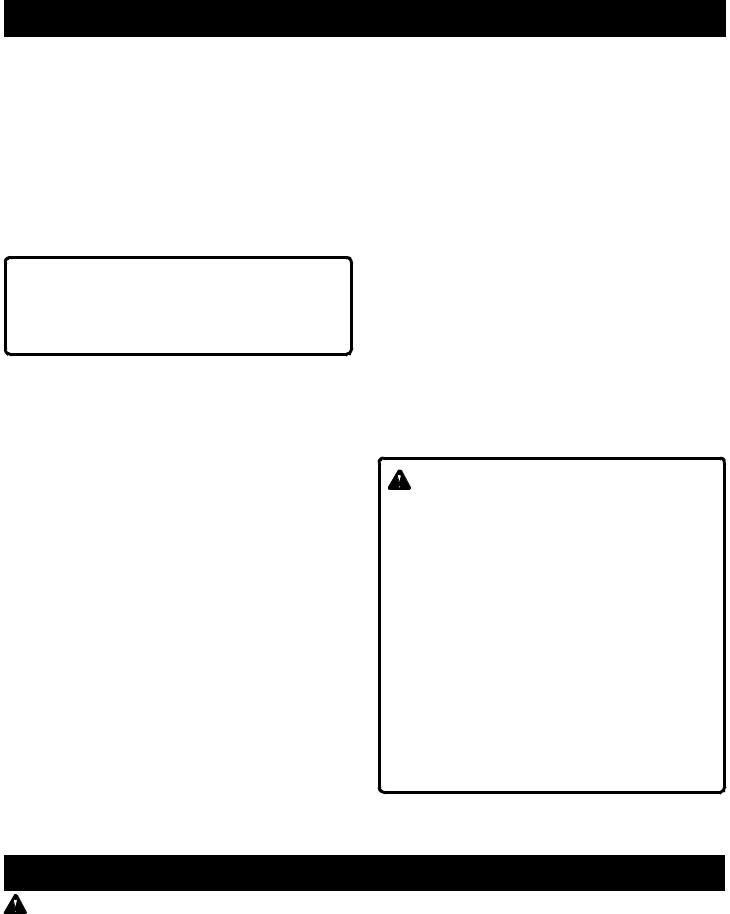
RULES FOR SAFE OPERATION
■AVOID AWKWARD OPERATIONS AND HAND POSITIONS where a sudden slip could cause your hand to move into the blade. ALWAYS make sure you have good balance.
■ALLOW THE MOTOR TO COME UP TO FULL SPEED before starting a cut to avoid binding or stalling.
■DO NOT USE TOOL IF SWITCH DOES NOT TURN IT ON AND OFF. Have defective switches replaced by an authorized service center.
■REPLACEMENT PARTS. All repairs, whether electrical or mechanical, should be made by a qualified service technician at an authorized service center.
 WARNING:
WARNING:
When servicing use only identical Ryobi replacement parts. Use of any other parts may create a hazard or cause product damage.
■KEEP HANDS AWAY FROM CUTTING AREA. Do not hand hold pieces so small that your fingers go under the blade guard. Do not reach underneath work or in blade cutting path with your hands and fingers for any reason.
■NEVER CUT MORE THAN ONE PIECE AT A TIME or stack more than one workpiece on the saw table at a time.
■FIRMLY CLAMP OR BOLT your saw to a stable, level workbench or table. The most comfortable table height is approximately waist height.
■DO NOT FEED THE MATERIAL TOO QUICKLY. Do not force the workpiece against the blade.
■USE ONLY CORRECT BLADES. Use the right blade size, style and cutting speed for the material and the type of cut. Blade teeth should point down toward the table.
■BEFORE MAKING A CUT, BE SURE ALL ADJUSTMENTS ARE SECURE.
■ALWAYS SUPPORT LARGE WORKPIECES while cutting to minimize risk of blade pinching and kickback. Saw may slip, walk or slide while cutting large or heavy boards.
■DO NOT REMOVE JAMMED CUTOFF PIECES until blade has stopped.
■NEVER START THE TOOL when the blade is in contact with the workpiece.
■NEVER TOUCH BLADE or other moving parts during use.
■BEFORE CHANGING THE SETUP, REMOVING COVERS, GUARDS OR BLADES, unplug the saw and remove the switch key.
■KEEP BLADES CLEAN, SHARP, AND WITH SUFFICIENT SET. Sharp blades minimize stalling and kickbacks.
■ALWAYS TURN OFF SAW before disconnecting it to avoid accidental starting when reconnecting to a power source.
■DO NOT OPERATE THIS TOOL WHILE UNDER THE INFLUENCE OF DRUGS, ALCOHOL OR ANY MEDICATION.
■STAY ALERT AND EXERCISE CONTROL. Watch what you are doing and use common sense. Do not operate tool when you are tired. Do not rush.
■MAKE SURE WORK AREA HAS AMPLE LIGHTING to see the work and that no obstructions will interfere with safe operation BEFORE performing any work using your saw.
■SAVE THESE INSTRUCTIONS. Refer to them frequently and use them to instruct other users. If you loan someone this tool, loan them these instructions also.
WARNING:
Some dust created by power sanding, sawing, grinding, drilling, and other construction activities contains chemicals known to cause cancer, birth defects or other reproductive harm. Some examples of these chemicals are:
•lead from lead-based paints,
•crystalline silica from bricks and cement and other masonry products, and
•arsenic and chromium from chemically-treated lumber.
Your risk from these exposures varies, depending on how often you do this type of work. To reduce your exposure to these chemicals, work in a well ventilated area, and work with approved safety equipment, such as those dust masks that are specially designed to filter out microscopic particles.
SAVE THESE INSTRUCTIONS
ATTENTION:
WARNING:
The blade guides have been preset at the factory. These settings are functional for some applications. We recommend that you check and adjust blade guide settings before first use of your saw. Refer to “ ADJUSTING THRUST BEARINGS, BLADE GUIDE SUPPORT, AND BLADE GUIDES” procedures explained in the ADJUSTMENTS section of this operator’s manual.
Page 5
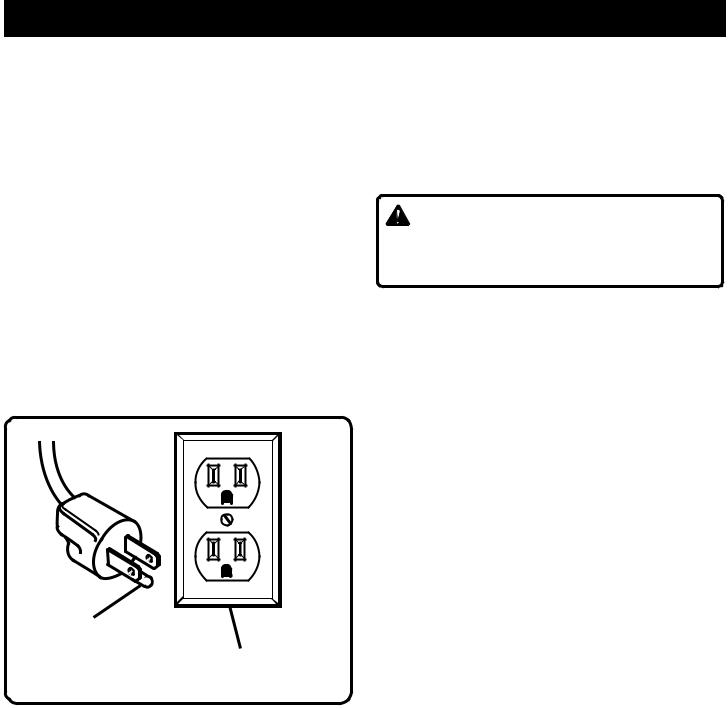
ELECTRICAL
EXTENSION CORDS
Use only 3-wire extension cords that have 3-prong grounding plugs and 3-pole receptacles that accept the tool's plug. When using a power tool at a considerable distance from the power source, use an extension cord heavy enough to carry the current that the tool will draw. An undersized extension cord will cause a drop in line voltage resulting in a loss of power and causing the motor to overheat. Use the chart provided below to determine the minimum wire size required in an extension cord. Only round jacketed cords listed by Underwriter's Laboratories (UL) should be used.
Length of Extension Cord |
Wire Size (A.W.G.) |
Up to 25 feet |
16 |
26-50 feet |
16 |
51-100 feet |
16 |
When working with the tool outdoors, use an extension cord that is designed for outside use. This is indicated by the letters WA on the cord's jacket.
Before using an extension cord, inspect it for loose or exposed wires and cut or worn insulation.
GROUNDING
PIN
COVER OF GROUNDED
OUTLET BOX
Fig. 1
ELECTRICAL CONNECTION
Your band saw is powered by a precision built electric motor. It should be connected to a power supply that is 120 volts, 60Hz, AC only (normal household current). Do not operate this tool on direct current (DC). A substantial voltage drop will cause a loss of power and the motor will overheat. If the machine does not operate when plugged into an outlet, double check the power supply.
CAUTION:
Keep the cord away from the cutting area and position the cord so that it will not be caught on materials, tools, or other objects during cutting.
GROUNDING INSTRUCTIONS
In the event of a malfunction or breakdown, grounding provides a path of least resistance for electric current to reduce the risk of electric shock. This tool is equipped with an electric cord having an equipment-grounding conductor and a grounding plug. The plug must be plugged into a matching outlet that is properly installed and grounded in accordance with all local codes and ordinances.
Do not modify the plug provided. If it will not fit the outlet, have the proper outlet installed by a qualified electrician. Improper connection of the equipment-grounding conductor can result in a risk of electric shock. The conductor, with insulation having an outer surface that is green with or without yellow stripes, is the equipment-grounding conductor. If repair or replacement of the electric cord or plug is necessary, do not connect the equipment-grounding conductor to a live terminal.
Check with a qualified electrician or service personnel if the grounding instructions are not completely understood, or if in doubt as to whether the tool is properly grounded.
Repair or replace a damaged or worn cord immediately.
This tool is intended for use on a circuit that has an outlet like the one shown in Figure 1. It also has a grounding pin like the one shown.
Page 6
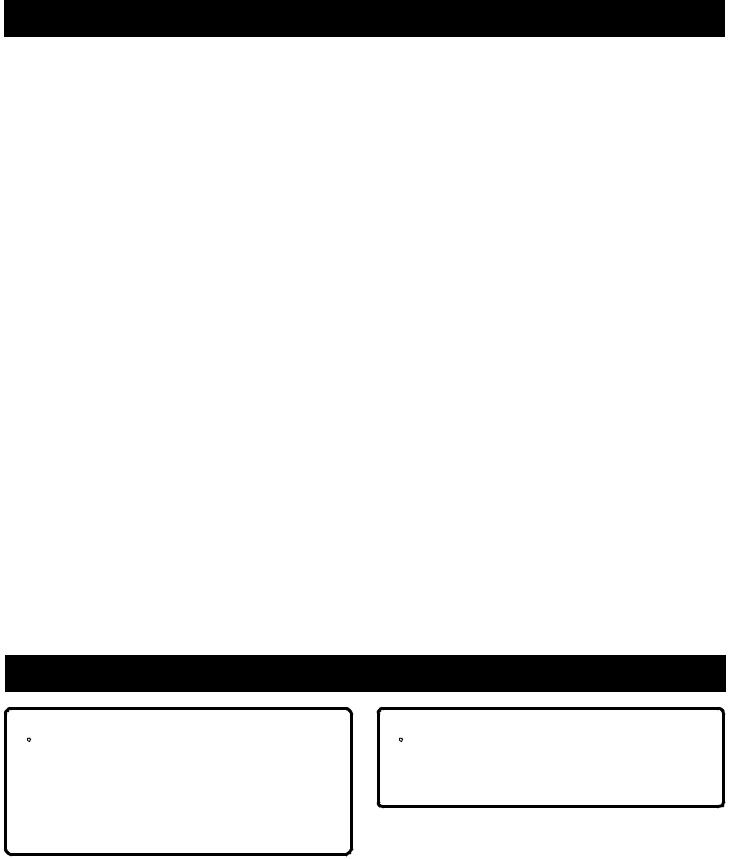
GLOSSARY OF TERMS FOR WOODWORKING
Bevel Cut
A cutting operation made with the saw table at any angle other than 90° to the blade.
Compound Cut
A compound cut is a cut made using a miter angle and a bevel angle at the same time.
Crosscut
A cutting or shaping operation made across the grain or the width of the workpiece.
Freehand (for band saw)
Performing a cut without the workpiece properly supported on the saw table.
Gum
A sticky, sap-based residue from wood products.
Kerf
The material removed by the blade in a through cut or the slot produced by the blade in a non-through cut or partial cut.
Kickback
A hazard that can occur when the blade binds or stalls, throwing the workpiece back toward operator.
Leading End
The end of the workpiece pushed into the cutting tool first.
Miter Cut
A cutting operation made with the workpiece at any angle to the blade other than 90° .
Push Stick
A device used to feed the workpiece through the saw blade during narrow cutting operations. It helps keep the operator's hands well away from the blade.
Resaw
A cutting operation to reduce the thickness of the workpiece to make thinner pieces.
Resin
A sticky, sap-based substance that has hardened.
Ripping
A cutting operation along the length of the workpiece.
Saw Blade Path
The area directly in line — over, under, behind or in front of the blade. As it applies to the workpiece, that area which will be or has been cut by the blade.
Set
The distance that the tip of the saw blade tooth is bent (or set) outward from the face of the blade.
SFPM
2,900 surface feet per minute, used in reference to surface speed of blade.
Throw-Back
Saw throwing back a workpiece in a manner similar to a kickback. Usually associated with a cause other than the kerf closing, such as a workpiece being dropped into the blade or being placed inadvertently in contact with the blade.
Through Sawing
Any cutting operation where the blade extends completely through the thickness of the workpiece.
Workpiece
The item on which the cutting operation is being done. The surfaces of a workpiece are commonly referred to as faces, ends, and edges.
Worktable
The surface on which the workpiece rests while performing a cutting or sanding operation.
UNPACKING
 WARNING:
WARNING:
To prevent accidental starting that could cause possible serious personal injury, assemble all parts to your saw before connecting it to power supply. Saw should never be connected to power supply when you are assembling parts, making adjustments, installing or removing blades, or when not in use.
■ Carefully remove all parts from the carton and place the saw on a level work surface. Separate and check against the list of loose parts.
 WARNING:
WARNING:
If any parts are missing, do not operate this tool until the missing parts are replaced. Failure to do so could result in possible serious personal injury.
■Do not discard the packing materials until you have carefully inspected the saw, identified all parts, and satisfactorily operated your new saw.
Note: If any parts are damaged or missing, do not attempt to plug in the power cord and turn the switch on until the damaged or missing parts are obtained and are installed correctly.
Page 7
